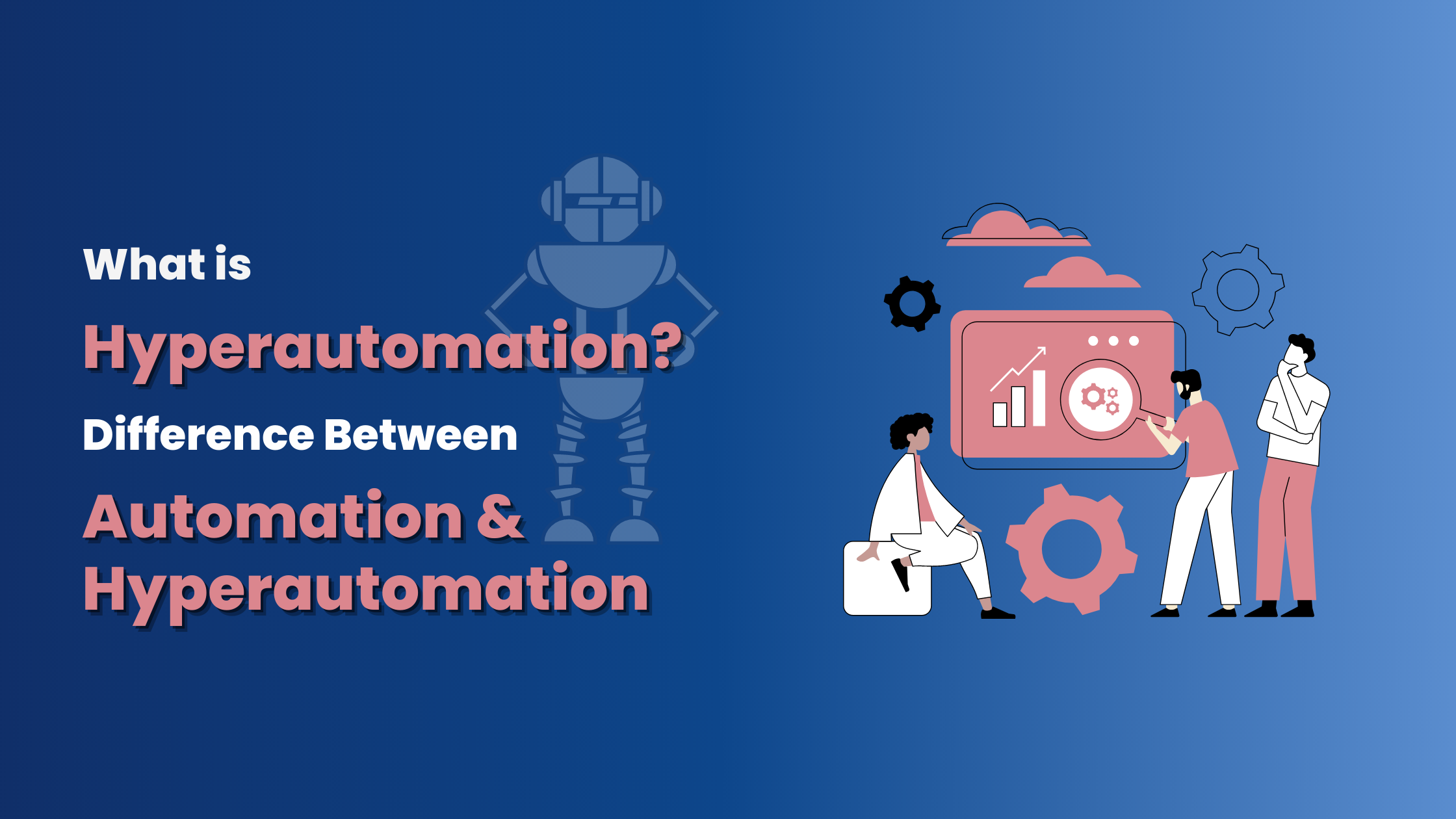The term Hyper Automation was first mentioned by Gartner in his report called “Strategic Technology Trends for 2020.” After that, this term received immense popularity and traction. Although, there is still not much knowledge about the difference between automation and hyper-automation. But, not anymore as this blog will clear all the confusion about these two terms. Start reading below to know everything in detail.
Why is Hyper Automation?
So, let’s start with hyper automation. As Gartner, in his report stated, “hyper automation deals with the application of advanced technologies, including artificial intelligence (AI) and machine learning (ML) to increasingly automate processes and augment humans. Hyper Automation extends across a range of tools that can be automated, but also refers to the sophistication of the automation (i.e., discover, analyze, design, automate, measure, monitor, reassess.)”
To simply explain this, hyper automation is basically the expanded form of automation. It uses advanced technology upon the prevailing automation process to easily do impossible tasks. In this new era of digital technology, customers look for personalized services no matter what the company’s size. Hence, to meet these demands, companies are also looking forward to using enhanced customer interactions.
What is Automation?
The main motive of automation is to reduce the need for human effort. It is designed to complete repetitive tasks without errors in a faster way. As a result, it saves time and resources. The automation in software testing is also called intelligent automation which is efficiently used for business process management or BPM.
This process consists of artificial intelligence, robotic processes, as well as machine learning. Moreover, RPA (robotic process automation) is not considered intelligent automation. It can do simple tasks and support decision-making processes made by humans.
What is the Difference Between Automation and Hyper Automation?
Both automation and hyper automation are part of the same periphery. Look at the table below for a brief understanding.
| Hyper Automation | Automation | |
| Sophistication | AI based process | Task oriented and RPA based automation |
| Coverage | Things eligible for automation are automated | Automation is done according to requirement and relevance |
| Required Technologies | Performed by various machine learning, automation tools, and many others | Automation Tools are used |
| Outcome | Efficient and Smart Operations | Efficient operations |
| Scope | It comprise of various technologies and platforms | One platform can be used for simple task of automation |
Areas Where Hyper Automation and Automation Can Boost Business Process
Both hyper automation and automation are advanced forms of RPA technology. They are empowered with various technologies such as process mining, machine learning, artificial intelligence, digital twins, etc.
Automation is crucial for any transformation that a company looks at in the digital world. But, certain limitations come with the RPA tools. So, these are some of the areas where both hyper automation and automation can be applied.
#1- Process Mining
Firstly, process mining is efficient in understanding the current situation of the company. To apply hyper automation, having accurate information about the business process is crucial. Thus, one must have a clear understanding of how the business is operated. Upon that, process mining gives detailed information to automate everything rightfully.
#2- Order Management and Accounts Payable
Manual tasks undertaken by the experts can eventually lead to errors which increases the timespan. However, hyper automation eliminates the risks and saves a lot of time. So, the experts can totally concentrate on responding, receiving, accounts payable, invoices, etc. Significantly, other processes, such as extracting, retrieving, and other tasks of order management can be completed through hyper automation.
#3- Live Agent Replacement
Thirdly, hyper automation also removes the necessary need of completing manual tasks by introducing bots. It goes through the business process and develops bots for automating tasks. Subsequently, those bots become the first communication point for customers and help them to navigate across the websites.
Key Differences between Automation and Hyper Automation
Read below to know the difference between Automation and Hyper Automation in detail.
#1- Simulating the process of Human Reasoning
To start, RPA along with hyper automation follows a progression of specific actions. These actions stand the same for each task. Thus, hyper automation is the expanded form of RPA comprising automation tools to make crucial decisions.
These decisions vary depending on the collected data and factors. It can also detect the product quality to meet the mandatory standards.
#2- Essentially focus on Business Outcomes
With the help of RPA, testers can automate every task as a sole function. Interestingly, hyper automation pinpoints every single task available to complete the business process. All these things start by defining the goals and the expected outcome.
Hence, the machine learning and artificial intelligence side of hyper automation will be helpful for companies. It can easily predict the options of a product for a customer by analyzing their history.
#3- Integrating Natural Language Processing, Machine Learning, and Artificial Intelligence
For simulating the power of human reasoning, hyper automation depends on specific technologies. These technologies help in taking predictive decisions depending on data. To give an example, hyper automation can use the history of previous purchases to send deliveries to a specific location.
Hence, hyper automation also earns from every decision and eventually makes smart decisions. But, it is evident that data quality largely affects if the reasoning will be successful for hyper automation.
#4- Empowering Future Generations with Hyper Automation
After automating any process by integrating RPA, that task appears on the silo automatically. Doing this can lead to difficulty combining it with other tasks. Thus, there should be a certain limit on the number of tasks required to perform.
Businesses can smoothly amend and amplify the process with the help of hyper automation. The reason behind this is that reasoning is formed into hyper automation which will empower future hyper automation.
Automation or Hyper Automation- Which One to Choose?
So, which one is better for your business? Following discussion can help to make the final decision.
- Gather More Knowledge On Automation Tools
One of the important tasks is to research the tools that meet the company’s goals. Implementing hyper automation will go in vain if the business doesn’t require it. Thus, it is an essential task to find the right tools. It is best to check development tools with low code. These useful solutions help connect with workflows and understand how they are different from traditional automation.
- Know the Future Goals of the Company
Identifying automation is essential to proceed hyper automation process for business operations. Before implementing automation, figure out where it is required the most. Also, analyze how to get the best outcome from it. Then, one can use those outcomes and measure their profitability and impact on the business.
- Choose the Sustainable Option
Selecting any tool which doesn’t match the company’s needs will drain the company’s money and time. Therefore, focus on implementing those tools that work best in the long run. So, being conscious about futuristic tools and advancement will carve the way towards success without any hindrance.
Conclusion
Want to transform the business? The above discussion about hyper automation and automation can play a crucial role. In the current scenario, hyper automation is important to have but first determine your goals. To conclude, choose a cost-efficient option for software testing.

